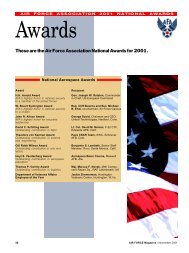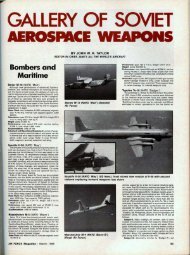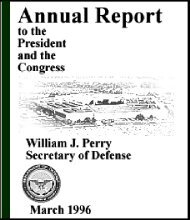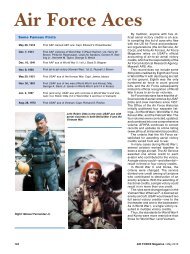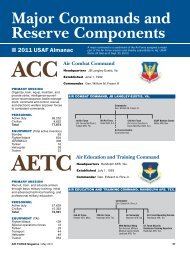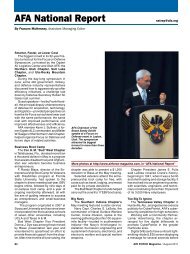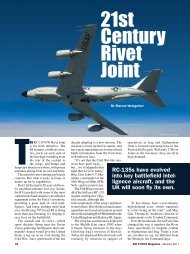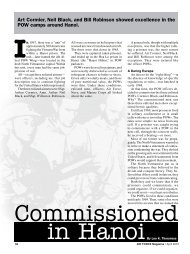1997 Annual Defense Report Table of Contents - Air Force Magazine
1997 Annual Defense Report Table of Contents - Air Force Magazine
1997 Annual Defense Report Table of Contents - Air Force Magazine
Create successful ePaper yourself
Turn your PDF publications into a flip-book with our unique Google optimized e-Paper software.
and maintained its portion <strong>of</strong> the zone without any major incidents. Task <strong>Force</strong> Eagle also assisted in<br />
separating the former warring factions, accounting for all heavy weapons, shutting down all air defense<br />
artillery systems within Bosnia, and getting each faction's army back into their barracks.<br />
In addition to the demanding mission in Bosnia, the United States has participated in other peace<br />
operations designed to defuse potentially explosive situations around the world. During 1996, significant<br />
U.S. participation was limited to two UN missions -- Haiti (UNMIH) and the Former Yugoslav Republic<br />
<strong>of</strong> Macedonia (UNPREDEP). A small number <strong>of</strong> U.S. military personnel also served as military observers<br />
or headquarters staff in other UN peace operations in the Western Sahara, the Republic <strong>of</strong> Georgia, Iraq-<br />
Kuwait, and Eastern Slavonia. Lastly, the United States also contributed forces to non-UN peacekeeping<br />
missions in the Sinai as part <strong>of</strong> the Multinational <strong>Force</strong> and Observers and along the Peru-Ecuador border<br />
as part <strong>of</strong> the Military Observer Mission, in order to promote stability given a long-standing territorial<br />
dispute.<br />
In many cases humanitarian assistance activities go hand-in-hand with peace operations. In this regard,<br />
humanitarian assistance bolsters peace operations as well as mitigating human suffering. Other situations,<br />
such as natural disasters, can destabilize a region by destroying shelter and infrastructure, disrupting<br />
commerce, preventing effective government, and causing widespread human suffering. U.S. military<br />
forces and assets are frequently called upon to initiate international efforts to meet urgent humanitarian<br />
needs and prevent instability from occurring after manmade and natural disasters. Assisting countries in<br />
coping with such events, and thereby promoting good will, is integral to the U.S. strategy <strong>of</strong> engagement<br />
and enlargement. Humanitarian assistance not only provides relief from suffering, but also assists in<br />
returning victims <strong>of</strong> violence and disasters to the path <strong>of</strong> recovery and sustainable development.<br />
Therefore, the Department <strong>of</strong> <strong>Defense</strong> actively seeks to improve the capabilities <strong>of</strong> the international<br />
community to deal effectively with humanitarian crises by developing closer ties with and providing<br />
assistance to international agencies, nongovernmental organizations, private voluntary organizations, and<br />
other federal agencies that contribute to relief operations.<br />
In 1996, approximately 100 countries benefited from DoD humanitarian assistance. DoD provided<br />
humanitarian assistance in support <strong>of</strong> several major DoD operations and U.S. government initiatives. In<br />
Operation Pacific Haven, for example, U.S. armed forces facilitated the evacuation and care <strong>of</strong> thousands<br />
<strong>of</strong> Kurds and other peoples from Northern Iraq, who were evacuated by the United States in response to<br />
threats to them by the Iraqi government. The Department <strong>of</strong> <strong>Defense</strong> has assisted, as well, in the<br />
emergency and routine transport <strong>of</strong> relief supplies provided by both private and government relief<br />
organizations, including such private organizations as AmeriCares and U.S. government agencies such as<br />
the U.S. Agency for International Development. During 1996, DoD provided emergency transportation <strong>of</strong><br />
relief supplies in response to natural disasters in China, Nepal, Kazakstan, Honduras, St. Maarten, and<br />
Indonesia. During the same time, the Department also significantly expanded its humanitarian demining<br />
program to train and assist other countries in developing effective demining programs and to expand<br />
efforts to develop better mine detection and mine clearing technology for use in the many countries still<br />
plagued by mines sown during prolonged internal conflicts.<br />
When the United States considers involvement in humanitarian assistance operations, decisions focus on<br />
the use <strong>of</strong> military forces rather than the use <strong>of</strong> force. Generally, the military is not the most appropriate<br />
tool to address humanitarian concerns. But under certain conditions, the use <strong>of</strong> U.S. military forces may<br />
be appropriate: when a humanitarian catastrophe dwarfs the ability <strong>of</strong> civilian relief agencies to respond;<br />
when the need for relief is urgent and only the military has the ability to jump-start the longer-term<br />
response to the disaster; when the response requires resources unique to the military; and when the risk to<br />
U.S. troops is minimal.<br />
13


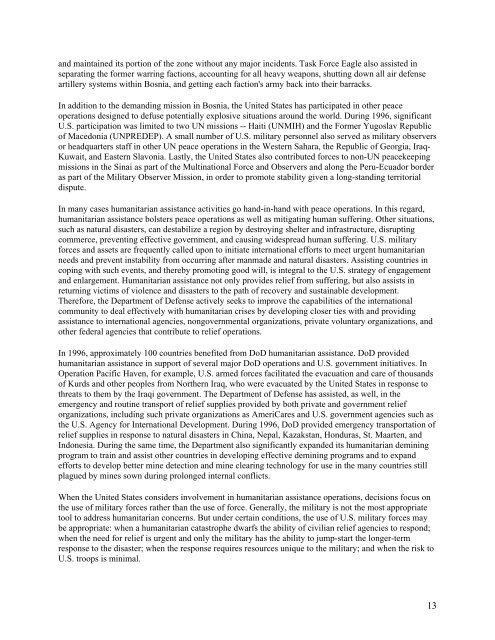
![[PDF] Foulois - Air Force Magazine](https://img.yumpu.com/13391007/1/190x253/pdf-foulois-air-force-magazine.jpg?quality=85)


